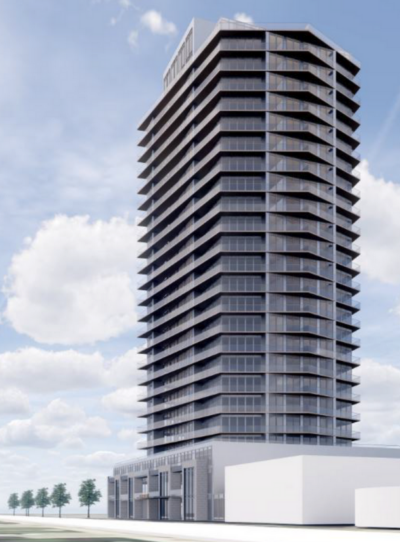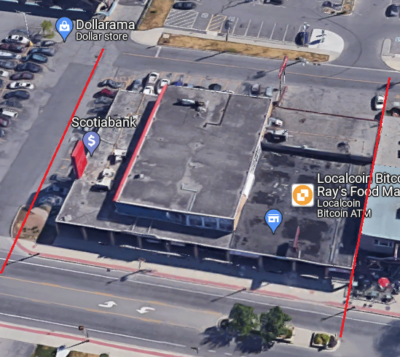 By Pepper Parr
By Pepper Parr
September 10th, 2023
BURLINGTON, ON
After a decent summer break City Council gets back to the grind with Standing Committee meetings on two days of the week.

Approved at a recent OLT hearing for 27 storeys. Traffic will enter the underground parking from John.
One item that will get discussed is the 26 story tower that was approved at a recent Ontario Land Tribunal meeting recently.
It will have a major impact on one of the more popular watering holes in the city.
The NoFrills Plaza on the North side of the site will get developed at some point. The thinking has been to move to supermarket closer to Brant Street with underground parking, some resident at the rear and a pathway along Rambo Creek which is on the eastern side of the site.
Mark Bales, the tough guy for most of the Carriage Gate developments is on the OLT appeal as representing Carriage Gate.
The development contemplates a mixed use development, including a 27-storey mixed use building (inclusive of a mechanical penthouse and elevator machine room) and a maximum of 259 residential units. The development includes retail / commercial / office uses on the ground floor and a maximum permitted height of 90 metres

This part of the city will look a lot different in five years. Someone will pick up the Joe Dogs site, it is owned by a pharmacist in Brampton whose interests are in renting properties – not in developing.
The tower will rise to the north of Joe Dogs – how they will manage to operate with construction taking place – not yards but literally inches away will be interesting.

Never one to miss a photo op, ward 2 Councillor Lisa Kearns lives a block to the west of the development site.
It’s a ward two development which will have Councillor Lisa Kearns all over the decision. Kearns sees that is as her turf – it will be interesting to hear what she has to say.
John Street, at the rear of the development, is not actually a street – officially it is a lane that some want to see pushed north right up to Victoria.

The two red lines show the boundary of the development. Joe Dogs isn’t inside those two red lines.















All commenters are correct in my view but there are three points that I think deserve emphasis. First, and without impugning the integrity of the Integrity Commissioner, he/she is paid help, exercises his/her mandate at the discretion of Council and has absolutely no enforcement powers. Secondly, Council accepts, rejects or varies the recommendations and findings of the Integrity Commissioner at their pleasure. Finally, not only has the Integrity Commissioner used different criteria for determining exactly the same conflict, the criterion itself is ill applied. The Commissioner, in both cases, has used a notification criterion as a ‘rule of thumb’ for determining conflict. It’s like using a grape to determine what a cherry tastes like because they’re both fruit. The whole thing is absurd. Conflicts and similar issues need to be determined by a completely independent body with the power to enforce their findings.
“Regarding the Integrity Commissioner statement on a so-called “rule of thumb” we need a correct description of what they said to start. The only evidence of this available is from the Advice Memorandum of March 22, 2022 to Councilor Galbraith. This follows in quotes verbatim.”
“”Proximity to a property under consideration is a ‘flag’ to members of Council, to stop and consider whether they may have a conflict of interest in participating in the matter. Distance alone is not the determining fact, but can be used as a reasonable ‘rule of thumb’ to determine potential for a possible financial impact arising from development applications.”
“With respect to the determination of a specific distance beyond which a member of council who owns a property would not be considered to have a conflict of interest, although there are no hard and fast rules, we consider that the distance utilized for Notice under the Planning Act provides reasonably good guidance for determining the appropriate distance beyond which impact might be considered ‘remote and insignificant’ for most planning and development applications.
“Your properties all fall clearly within the area being contemplated as the study area, and which will be subject to policy amendments to support and guide future development under the relevant official planning documents.”
“Based on the original map of the study area, which merely delineated the boundary of the MTSA Aldershot GO area but did not identified any proposed changes to the land uses, it would have been reasonable to consider your interest as an interest in common.”
“However, in light of the more granular level of detail now under review, which includes proposed changes to land uses which have a direct affect on the potential uses for your properties, and which will affect your properties differently –in degree and in nature – from other properties throughout the study area, we would not consider your interest to be an interest in common any longer.”
“This is underscored by the fact that two of your properties are, in fact, vacant and you are awaiting planning changes to enable redevelopment, with possible land assembly to enhance the opportunities.”
“It would be reasonable to characterize you as an investor in the area, whose investment return will be realized through redevelopment, and for this reason, your interest could not properly be considered an interest in common.”
“Remote or Insignificant:”
“While it is often relevant to consider whether an interest could be considered “remote or insignificant” as referenced in the MCIA, s. 4(k), we would not consider this exception to be relevant in your circumstances.”
“The applicable test to determine whether a member has an interest that is so remote or insignificant in its nature such that it cannot reasonably
be regarded as likely to influence the member is set out in Whiteley v. Schnurr (1999), 4MPLR (3d) 309. The question to be asked is as follows:”
Would a reasonable elector, being apprised of all the circumstance, be more likely
than not to regard the interest of the councillor as likely to influence that councillor’s action and decision on the question?”
In another case similar to this it was concluded in law, in the case of Threader vs. Treasury Board, the Federal Court of Appeal put the test as follows: “Would an informed person, viewing the matter realistically and practically and having thought it through, think it more likely than not that the public servant, whether consciously or unconsciously, be influenced in the performance of his public duties by considerations of his private interests.”
What is significant in evaluating conflict of interest cases is that there need not be an actual conflict of interest. As the B.C. Court of Appeal has noted, merely the potential for conflict is sufficient. Another aspect of conflict of interest law is that the “rule of Caesar’s wife” applies with particular rigour to more senior executives.
Overall, the distance criteria was stated in terms of proximity and as a flag, not a determinant factor in their Advice Memorandum. Notification distance (120 meters) was not stated as certain or definite for conflict. It is a guidance only, for purposes of determining an appropriate distance beyond which the impact or interest or financial conflict, under MCIA, s. 4 (k) can be considered “remote and insignificant.”
It was concluded by IC that this distance is not suitable for the Councilor circumstances, as his pecuniary interest is not “remote and insignificant’.
This applicable test was never mentioned again by the IC and was omitted completely as a response to a complaint raised in the IC Disposition Report.
If the OLT has already approved it, what is there to discuss?
Get shovels in the ground!
If Councillor Kearns lives so close shouldn’t she be recusing herself?
Interesting that we now have a mayor and two councillors living in spitting distance of so many of these big downtown developments. I too wonder if they should be recusing. The mayor lives on the same little street as several of them. Then of course we have Galbraith and his businesses on Plains Road right across from and beside big developments and developer lands. He refuses to speak with the constituents who have raised this concern, the mayor supports his stance and he got big campaign donations from some of the same developers. It’s pretty clear the developers have it made here and everywhere in Ontario.
Addendum: Lisa inquired with Burlington’s integrity commissioner back in 2020 on whether she had a conflict on this development. She declared verbally at the September 7, 2021 Statutory Public Meeting that Principles Integrity had advised that her living 260 metres from the site (“a one minute walk” as described by Lisa), being outside of their “reasonably good guidance of 150 metres for zoning matters” cleared her of the need for recusal. These quotes come from my watching the recording.
Some may question this 150 metre “guidance” and wonder where that figure comes from and if it is reasonable. But that is what they ruled and Lisa was very transparent on the matter. Council reacted with silence.
This is interesting contradiction. As Lynn says, In September 2021, the IC advised Lisa that her conflict distance, and need for recusal for her residence, was 150 meters.
In November 2022, IC accepted a distance of 120 meters that Galbraith had self-selected himself and only for any application that was in said proximity to his property. This was done in a conflict of interest complaint to the IC.
The point of this comment is to highlight this contradiction in the conflict distances and properties the IC used for the two Councilors.
Unlike for Lisa, the IC did not similarily consider the Councilor Galbraith residence for the Solid Gold development application determination of conflict and recusal. This application is right across and down Clearview Ave. from that residence. Solid Gold was one application that was subject to the conflict complaint.
In fact, in the distance comparisons the IC used, the Galbraith residence was not used at all, despite being a candidate for being the closest property.
The residence is a Councillor property and was declared as a conflict with respect to the 1085 Clearview application. Thus it is appropriate to measure the distance from the Solid Gold application to the residence property. It is identifiable as the nearest property and nearest property line, as required by the Planning Act procedures.
e context – different and opposite outcome.I have a GIS image observing and measuring the distance from the nearest property line of the Solid Gold application (1025 Cooke Blvd and 53-71 Plains Rd.), which is the East property line, on Clearview Ave, to the Galbraith residence nearest property line. This is 146 meters.
The Galbraith residence there is the nearest property, and nearest property line to the appplication. This is the determinate way that Planning Act notification distances are measured using application site plans.
The conclusion of the point here is: using the 120 meters that Galbraith and the IC use for their manner of determination of the Solid Gold conflict, there is no conflict.
On the other hand, using the 150 meter distance used by the IC for Lisa, there is a conflict regarding Galbraith and Solid Gold.
So I think the reader can figure out what the point says.
The IC picked the Councilor property that was not the correct nearest property and property line to Solid Gold nearest property line, and also picked what the conflict distance was, with the result that there is no conflict.
This contradiction indicates something is very wrong if this can happen – same context for Councilors but different IC assumptions and outcomes.
Interesting that there might be a “pathway along Rambo Creek which is on the eastern side of the site.” I wonder if the City would put an orange fence along the creek edges to protect the trees and bushes already established? Unfortunately, I think I know the answer, given past City behaviour.
In addition, “John Street, at the rear of the development, is not actually a street – officially it is a lane that some want to see pushed north right up to Victoria.” For what purpose – to tarmac the sides of the creek so there is even more run-off and no habitat corridor? But the answer is “of course”, why consider natural pathways when one can have hard surfaces? Poor creek, poor wildlife and ultimately, poor Burlingtonians.